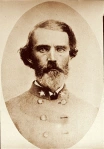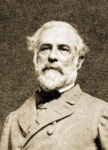See Also:
Tebeauville, Old No. Nine
Prior to the Civil War General Levi J. Knight, of present-day Ray City, GA, invested in the development of railroads across Wiregrass Georgia. Two of Knight’s investments were in the Brunswick & Florida Railroad, and the Atlantic & Gulf Railroad, the junction of which was at Tebeauville, GA. When the Civil War commenced, Knight’s railroads were still being constructed, largely with the labor of enslaved African-Americans. During early part of the war, Knight’s company of Berrien Minute Men was transported on these railroads to their posts at the coastal defenses of Georgia.
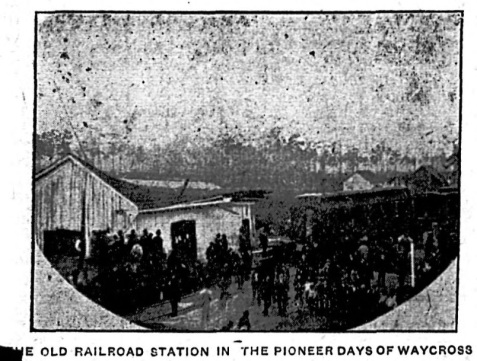
Depot at station No. Nine, Tebeauville, GA (now Waycross, GA) was the junction point of the Brunswick & Florida Railroad with the Savannah, Albany & Gulf Railroad and the Atlantic & Gulf Railroad.
Although the Brunswick & Florida Railroad had been chartered in 1837, construction did not commence until 1856. The track was started at Brunswick, GA but by 1857, only 36 miles of rail had been completed. If completed, the B&F could move men and materials from ports on the Gulf of Mexico to the Brunswick port on the Atlantic in 24 hours “in case of war between this country and a foreign nation.” And there were plans that the B&F would make connections to bring passenger and freight traffic to Brunswick from as far west as Vicksburg, MS.
The short line Brunswick & Florida Railroad would run from Brunswick to the Savannah, Albany & Gulf Railroad station number nine, which was also to be a junction with the Atlantic & Gulf Railroad. The Atlantic & Gulf was intended to serve the two coastal railroads as a “Main Trunk” stretching across South Georgia. At Bainbridge, GA it was planned to serve the steamboat docks on the Flint River creating a passenger and freight connection to the Gulf of Mexico.
The junction point of the B&F, A&G and the S, A & G, was ninth station to be constructed on the line from Savannah and was situated just south of the Satilla River. The eponymous community which sprang up there was No. Nine. Blackshear, GA. was No. Eight and Glenmore, GA was No. 10.
In 1857, Philip Coleman Pendleton had settled his family at No. Nine before the tracks of the S, A & G or the B & F even reached the station. At Tebeauville, Pendleton engaged in farming and timber. He also served as postmaster and stated the first Sunday school in Ware County. (Pendleton had come from Sandersville, GA where he was co-owner of the Central Georgian newspaper, with O. C. Pope, Sr.)
At that time [1857] a Savannah company headed by James Screven, father of the late John Screven, was building a railroad from Savannah to Thomasville. The western terminus [of the Savannah, Albany and Gulf Railroad] was then at a point some twelve or fifteen miles east of Blackshear…The laying of the iron reached Mr. Pendleton’s place about a year later… The old stage road between Thomasville and Brunswick passed here, with a fork running to Burnt Fort, on the Satilla River. There was a post-office at this place called “Yankee Town.” It was so designated because northern people operated the stage coaches and they owned at this place a relay stable; but it passed away with the coming of the railroad, and Screven named the station ‘Pendleton’. The man thus honored took the first train to Savannah and caused the name to be changed to Tebeauville, after his father-in-law, Captain F. E. Tebeau, a member of one of the old Savannah families. Perhaps a year or so later a civil engineer came along surveying the route for the [Brunswick & Florida Railroad]. When he arrived at Tebeauville he made a side proposition to Mr. Pendleton to run the prospective city off in lots and to give him each alternate lot. Mr. Pendleton did not think that the man was authorized thus to approach him, and suggested that he tell the president of the road to see him in regard to the matter. Miffed at this rebuke, the engineer went back three or four miles pulling up the stakes as he went, and made a curve to miss Mr. Pendleton’s land. If one will stand at the crossing near Tebeau Creek, in the heart of Waycross, and look towards Brunswick, he can see the curve in the road [railroad tracks], caused by this effort of the engineer to make something on the side. – Georgia’s Men of Mark
The tracks of the Savannah, Albany and Gulf reached station No. Nine on July 4, 1859.
By 1859, 60 miles of B & F track had been laid stretching from Brunswick north around the headwaters of East River then westward toward Tebeauville. The B&F junction at station No. Nine completed a rail connection between Brunswick and Savannah and connected Brunswick with the “Main Trunk” Atlantic and Gulf Railroad.

Civil War era map of the Brunswick & Florida Railroad, running from Yankee Town, the post office at Tebeauville (now Waycross), GA, to Brunswick, GA – Atlas to Accompany the Official Records of the Union and Confederate Armies.
Construction of the A & G was progressing westward from Tebeauville toward Lowndes County, GA. The steel rails were imported from Le Havre, France. There were 1200 enslaved African Americans at work building the Atlantic & Gulf, making the railroad perhaps the largest single “owner” of enslaved people in Georgia. In 1859, 75 percent of railroads in the south were built with the labor of enslaved people and one-third of all southern lines worked 100 or enslaved laborers.

African Americans maintaining a southern railroad.
In 1859, 1200 enslaved African Americans labored to build the Atlantic & Gulf Railroad across Wiregrass Georgia, laying a little over a mile of track every week. The jubilee train reached Valdosta, GA on July 31,1860. Image: https://www.loc.gov/pictures/resource/cwpb.02135/
The southern railroads were dependent on enslaved black laborers for construction and maintenance, and sometimes operations. The enslaved workers were either the “property” of the railroads or leased from “slave owners”. “Sometimes owners were actually reluctant to hire out their enslaved laborers because of the extreme danger associated with rail construction and train operations; if they did so, they often would take out insurance on their [human] property from working on the riskiest tasks. Of course, those contractual provisions were not always obeyed, leading contractors and slave owners to the courtroom.” – From Here to Equality.
About 20 miles west of Tebeauville, railroad superintendent Gaspar J. Fulton made a side investment in real estate. Fulton purchased land along the tracks from John Smith, of Clinch County. However, no station was established there until the 1880s (now Argyle, GA).
By February 1860, the A & G track had crossed the Alapaha River near Carter’s Bridge about nine miles south of Milltown (now Lakeland, GA). By March 12, hundreds of bales of cotton were being shipped to Savannah from Station No. 13 at Stockton, GA, which was described as “‘quite a brisk little place, with its hotel and livery stable’ to say nothing of its numerous refreshment saloons.” There were 50 bales of cotton shipped from “Alapaha” on March 10. By about the end of the month at Station No. 13, there were “about 120 bales of cotton for shipment, and the warehouses crowded with western freight.” The May 1, 1860 annual report of the A & G [inclusive of the S, A&G] stated that in previous 12 months [during which track was extended from Tebeauville, GA to Naylor, GA] there were 4.8 million feet of lumber and timber shipped over the railroad.
The residents at Troupville, GA, then county seat of Lowndes, were hopeful that the town would be the site where the Atlantic and Gulf Railroad spanned the Withlacoochee River. By July 1860, the Atlantic and Gulf track extended 62 miles to near the Withlacoochee but the route passed four miles southeast of Troupeville and crossed the river eight miles downstream, sorely disappointing the town’s residents. The many of the town residents packed up and moved to the tracks, some even moving their houses, and founded the city of Valdosta, GA.
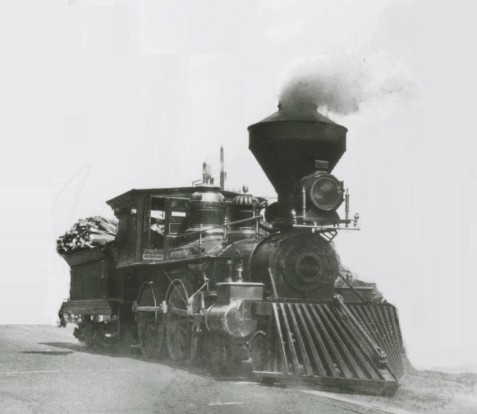
The Satilla was the first locomotive to arrive at Valdosta, July 30, 1860. The engines of the Atlantic & Gulf Railroad (Savannah, Albany & Gulf) were named for the rivers of South Georgia. The Satilla is on exhibit at the Henry Ford Museum, Dearborn, MI.
John Screven, president of the A & R reported that the tracks reached Valdosta on July 25, 1860.

The Augusta Daily Constitutionalist reported the completion of the Atlantic & Gulf railroad to Valdosta, GA
When the Civil War broke out, the completion of the Brunswick & Florida, the Savannah, Albany and Gulf, and the Atlantic & Gulf railroads became strategically important, although the threatening “foreign nation” was the United States. Troops from all over Wiregrass Georgia were mobilized on the railroads. P. C. Pendleton “was engaged in planting and looking after his splendid timbered lands when the war came on… “Tebeauville, though not a town of much size, at the outbreak of the war in 1861, nevertheless furnished several recruits to Colquitt’s Brigade” … [Pendleton] raised a company of volunteers in Ware county and upon its organization became a major of the 50th Georgia Regiment. – J. L. Walker, State Historian, DAR
During the war, the Sunday School at Tebeauville was superintended by Mrs. B. F. Williams, wife a Confederate army surgeon. Mrs. Williams lived a few miles from Tebeauville at Sunnyside, near the Satilla River. She also helped to organize a non-denominational church “composed of ‘Hard-Shells,’ Methodists, Baptists, and Presbyterians, that existed and flourished for years in perfect harmony. – J. L. Walker, State Historian, DAR
In 1861 the Berrien Minute Men, the Confederate infantry company raised by General Knight, traveled on the Brunswick & Florida from Station No. 9, (Tebeauville) to Brunswick. Per orders, Captain L. J. Knight took his company of Berrien Minute Men to the Georgia coast where they and other volunteer companies from South Georgia counties were garrisoned at Camp Semmes for the defense of the port at Brunswick, GA (Berrien Minute Men at Brunswick ~ July, 1861). The Confederate States government compensated the railroads for providing transportation.
Robert E. Lee stopped for a few hours in Tebeauville in 1861 while making a general survey of the Confederate coastal defenses. In a letter to his wife, transcribed in Recollections and Letters of General Robert E. Lee, he referenced the Battle of Port Royal, in which the 29th GA regiment was engaged, and mentioned plans to visit Brunswick:
“Savannah, November 18, 1861.
“My Dear Mary: This is the first moment I have had to write to you, and now am waiting the call to breakfast, on my way to Brunswick, Fernandina, etc. This is my second visit to Savannah. Night before last, I returned to Coosawhatchie, South Carolina, from Charleston, where I have placed my headquarters, and last night came here, arriving after midnight. I received in Charleston your letter from Shirley. It was a grievous disappointment to me not to have seen you, but better times will come, I hope…. You probably have seen the operations of the enemy’s fleet. Since their first attack they have been quiescent apparently, confining themselves to Hilton Head, where they are apparently fortifying.
“I have no time for more. Love to all.
“Yours very affectionately and truly,
“R. E. Lee.”
In his 1914 Georgia’s Men of Mark, historian Lucian Lamar Knight included:
It is one of the local traditions, to which the old residents point with great pride, that when in command of the coast defense, at the outbreak of the war, General Robert E. Lee stopped for a short while in Tebeauville. Many of the people who lived here then remember to have seen this Man of the Hour who still lives in the hearts of the people today. Among the the citizens who resided here then were the Tebeaus, the Reppards, the Remsharts, the Parkers, the Grovensteins, the Millers, the Behlottes, the Sweats, the Smiths and the Cottinghams. To this day many old timers refer to the section of [Waycross] where the Tebeauville station was located as “Old Nine”.
At the time of General Lee’s survey, the campfires of the Berrien Minute Men were made at garrisons defending Darien, GA, the next port north of Brunswick. “As a result of [General Lee’s] coastal survey, upon his return to Savannah 3 days later, he notified the War Department in Richmond of the confirmation of his previous opinion that the ‘entrance to Cumberland Sound and Brunswick and the water approaches to Savannah [including Fort Pulaski] and Charleston are the only points which it is proposed to defend.'” National Park Service
The defenses of Georgia’s sea islands were abandoned, their guns and men redeployed to defend the three southern ports. The Berrien Minute Men were moved to garrisons around the port of Savannah.
Ultimately, Levi J. Knight’s investment in the B&F railroad became another casualty of the Civil War. “The Brunswick and Florida Railroad was in operation up to the fall of 1863, when the Confederate Government seized it under the Impressment Act, tore up the rails, and distributed the property of the Company among other railroads, which were considered as leading military lines. The line of the B&F had become a liability as U.S forces had occupied Brunswick in early 1862.
P. C. Pendleton moved his family to Valdosta, GA in 1862 where after the war he established the South Georgia Times newspaper. His former business partner, O. C. Pope moved to Milltown in 1866 where he taught in the Milltown Academy.
In late 1867 Major Philip Coleman Pendleton again passed through Tebeauville as a passenger on the Atlantic & Gulf Railroad from Valdosta to Savannah, where he was sailing for Scotland. He was on a mission for the Lowndes Immigration Society to recruit Scottish immigrants to settle at Valdosta, GA, and work the cotton, as Wiregrass planters had an aversion to hiring and paying formerly enslaved laborers to do the work.
The town of Tebeauville was incorporated in 1866. “In 1869, the State of Georgia provided about $6 million in bonds to rebuild [the tracks from Tebeauville to Brunswick]. The railroad was then reorganized as the Brunswick and Albany Railroad.” Tebeauville was designated county seat of Ware County in 1873. It was incorporated as “Way Cross” on March 3, 1874. Waycross gets its name from the city’s location at key railroad junctions; lines from six directions meet at the city.
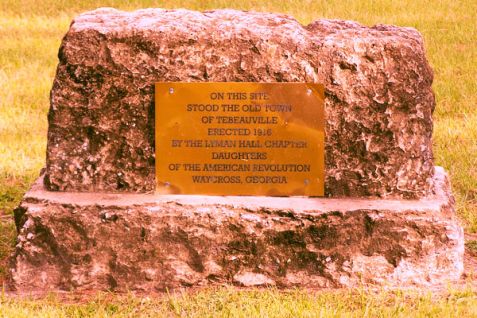
Tebeauville Historic Marker in Bertha Street Park, Waycross, GA, “On this site stood the old town of Tebeauville. Erected by the Lyman Hall Chapter, Daughters of the American Revolution, Waycross, GA.
The B&A went bankrupt in 1872 after a bond was nullified by the Georgia General Assembly. It was reorganized in 1882 and was then named the Brunswick and Western Railroad.
The name Tebeauville remained in use for the station at Waycross at least as late as 1889, as evidenced in railroad schedules and newspaper references.
(See source citations below)
Related Posts:
- General Levi J. Knight ~ Railroad Tycoon
- Lowndes Immigration Society, 1867
- Old Land Mark Gone ~ Death Of Uncle Billy Smith
- Berrien Minute Men at Brunswick ~ July, 1861
- Berrien Minute Men on Sapelo Island: Part 6
- 1899 Sketch of Old Lowndes County
- More About Troupville, GA and the Withlacoochee River
- Railroad Horror! 1888 Train wreck kills John T. Ray and 30-odd others.
- Southern Georgia: Railroad Pamphlet
- Thomas M Ray Founded Ray’s Mill in 1863
- The Commission of Major General Levi J. Knight
- Levi J. Knight and Lowndes First Superior Court
- Levi J. Knight and the Confederate Payroll Fraud
- L.E. Lastinger and Captain Knight’s Berrien Minutemen
- Levi J. Knight ~ Next Generation
- Reverend William A. Knight at old Troupville, GA
- Levi J. Knight’s Military Heritage
Sources:
Georgia.1836. Acts of the General Assembly of the state of Georgia passed in Milledgeville at an annual session in November and December 1835. An act to incorporate the Brunswick and Florida Railroad.pg 187.
United States. (1851). The statutes at large and treaties of the United States of America from. Boston: C.C. Little and J. Brown. pg 146
Dozier, Howard Douglas. 1920. A history of the Atlantic Coast Line Railroad. Houghton Mifflin. pg 79.
Phillips, Ulrich Bonnell. 1908. A history of transportation in the eastern cotton belt to 1860. pg 358.
Georgia Telegraph. Dec 20, 1853. From Milledgeville. Macon, GA. Pg 2
Georgia Telegraph. June 13, 1854. Minutes of the stockholders of the Brunswick and Florida Railroad. Macon, GA. Pg 3
Southern Recorder, May 15, 1855. Brunswick and Florida Railroad. Pg 2
Georgia Telegraph. Apr 8, 1856. Minutes of the Board of Commissioners of the Atlantic & Gulf Railroad Company, First Meeting, Wednesday, Feb 27, 1856. Macon, GA. Pg 3
United States. 1857. Appendix to the Congressional Globe containing speeches, important state papers, laws, etc., of the third session, Thirty-fourth Congress. Naval Depot at Brunswick, Georgia: Speech of Hon. A. Iverson of Georgia in the Senate, January 20, 1957. pg. 270-275.
Poor, H. V. (1869). Poor’s manual of railroads. New York: H.V. & H.W. Poor; [etc., etc. Pg. 337.
Loyless, T. W. (1902). Georgia’s public men 1902-1904. Atlanta, Ga: Byrd Print. Pp 166.
Miller, S.F. 1858. The bench and bar of Georgia: memoirs and sketches, with an appendix, containing a court roll from 1790 to 1857, etc. (1858). J. B. Lippincott & Co. Philadelphia. Pg 170
Milledgeville Federal Union, Nov. 18, 1856. Commercial Convention at Savannah. page 3. Milledgeville, GA.
United States of America, Bureau of the Census. Eighth Census of the United States, 1860. Washington, D.C.: National Archives and Records Administration, 1860. M653, 1,438 rolls. Census Place: Berrien, Georgia; Roll: M653_111; Page: 362; Image: 363.
Mitchell, S. Augustus. 1855. Mitchell’s new traveller’s guide through the United States and Canada. pg 87
Swayze, J. C., & H.P. Hill & Co. (1862). Hill & Swayze’s Confederate States rail-road & steam-boat guide: Containing the time-tables, fares, connections and distances on all the rail-roads of the Confederate States, also, the connecting lines of rail-roads, steamboats and stages, and will be accompanied by a complete guide to the principal hotels, with a large variety of valuable information. Griffin, Ga: Hill & Swayze.
Railga.com. Brunswick & Florida Railroad. https://railga.com/brunfl.html
Walker, J. L. (1911, Nov 11). Tabeauville. Waycross Evening Herald.
